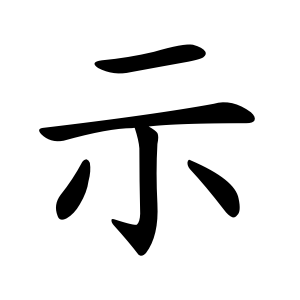示
- to show, to display, to demonstrate, to reveal, to indicate, to exhibit;
Etymology
It is a pictograph representing an altar with offerings arranged on it, symbolizing showing the offerings to the gods, hence meaning "to show" or "to display."
Usage in Korean
Characters using 示 as a radical often relate to concepts involving spirits, rituals, religion, faith, and etiquette.
Examples include:
神 (god/spirit)
祭 (sacrifice/ritual)
祀 (worship)
祈 (pray)
禱 (pray)
祝 (wish/bless)
福 (fortune)
禮 (ritual/propriety)
社 (earth deity or shrine)
祠 (ancestral shrine)
祥 (auspicious)
祖 (ancestor)
禁 (prohibit)
禦 (defend)
A similar character is 視 (to see), which shares the same pronunciation but differs in meaning: 示 is about "showing," whereas 視 is about "seeing."
Alternative forms
示 has variant forms when used as a component in other characters, either in the "foot" (발) position or the "side" (변) position:
1. When 示 appears in the foot (발) position, it is usually written as 示 in full form.
2. When it appears in the side (변) position, it often changes to the variant form 礻 (also written as ⺬).
Both forms, 礻 and ⺬, have been used interchangeably since ancient times.
In modern usage:
• In China and Japan, ⺬ is more commonly used.
• In Korea, 礻 is more commonly used.
However, this difference is not regarded as incorrect by any of the countries, and neither is treated as a mistake. In fact, Korean official naming standards explicitly allow the interchangeable use of 礻 and ⺬ even if one is not separately listed in the official hanja tables.
In practice in Korea both variants 礻 and ⺬ usually render as ⺬.
Many input systems prioritize showing characters with the 礻 radical first.
Authoritative Korean dictionaries like the Standard Korean Language Dictionary list characters under the 礻 radical form.
Even historical plaques like those on Gyeongbokgung’s Heungnyemun and Sungnyemun gates show the character 禮 in the 礻 form.
Examples of characters using 示 as a foot radical include:
禦 (to defend)
禁 (to prohibit)
票 (ticket)
祭 (ritual/sacrifice)
Examples of characters using the 礻 side radical include:
祿 (to grant)
神 (spirit)
禮 (rite)
社 (shrine)
Similar shape characters
The 礻 radical is visually very similar to the radical 衤 (clothing 衣 variant), differing by just one stroke, so care should be taken not to confuse them.
Also, the katakana ネ in Japanese looks similar but is unlikely to cause confusion because they rarely appear together in the same contexts.
Characters with 示
Words that derived from 示
- 一一火 (MMF)
- ⿱ 二 小
- ⿱ 一 𥘅
- ⿱ 一 𡭕
